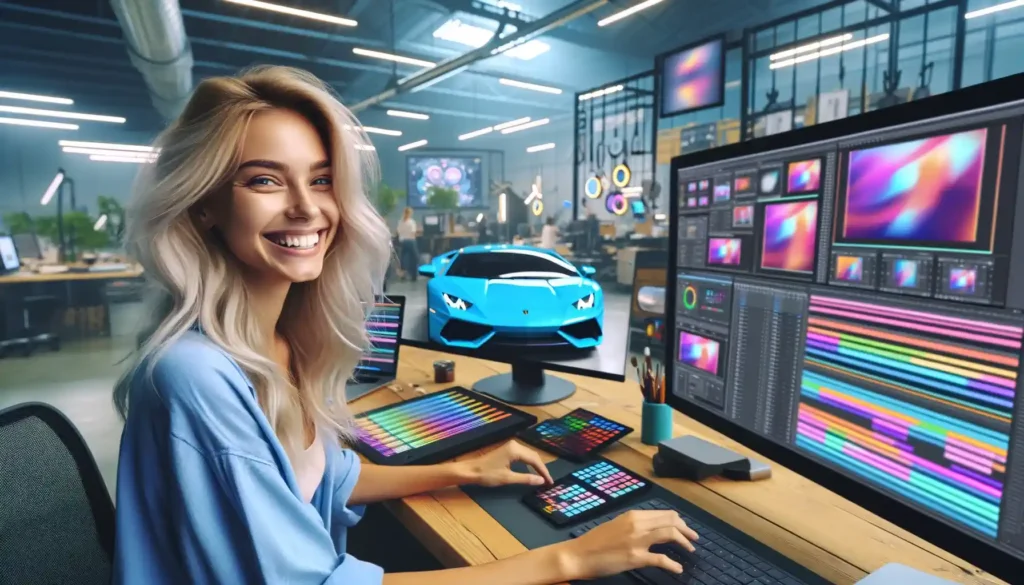How to Use Motion Design to Transform Your Book Trailer into a Viral Sensation. In the competitive world of book publishing, making your work stand out is crucial. One of the most effective tools at your disposal is the book trailer—a dynamic, visual promotion that captures the essence of your book in a way that traditional marketing methods cannot.

By incorporating motion design, you can elevate your book trailer from a simple advertisement to a viral sensation. Here’s how to do it:
1. Understand Your Audience and Book’s Theme
Before diving into motion design, it’s essential to thoroughly understand your target audience and the core themes of your book. This knowledge will guide the visual style, tone, and pace of your trailer. For example, a high-energy, fast-paced trailer might appeal to younger audiences, while a more subdued, narrative-driven approach may attract fans of literary fiction.
2. Write a Compelling Script
The script is the backbone of your trailer. It should be concise, focusing on the most intriguing parts of your book without giving too much away. Aim for a narrative that hooks viewers in the first few seconds. A good script includes:
- A strong opening line that piques interest.
- Key plot points and characters.
- A cliffhanger or question that leaves viewers wanting more.
3. Choose the Right Motion Design Elements
Motion design can transform a static image into a story with depth and excitement. Consider these elements:
- Typography: Dynamic text can convey key messages and evoke emotion.
- Color and Texture: Use colors and textures that reflect the mood of your book. Darker tones might suggest mystery or thriller genres, while bright, bold colors could enhance a comedy or romance.
- Animation: Character and environmental animations can bring scenes from your book to life, making the trailer more engaging.
4. Leverage Storyboarding
Storyboarding is crucial for planning your trailer’s visual sequence and ensuring that the story flows logically. Sketch out each scene, decide where motion design will be applied, and how it will enhance the story. This step helps avoid costly changes during the production phase.
5. Use High-Quality Audio
A trailer’s impact is often as much about sound as it is about visuals. Choose a soundtrack that complements the mood of your visuals. Consider hiring a professional voice-over artist to add a layer of professionalism. Sound effects can also heighten the action or drama in key scenes.
6. Integrate Seamless Transitions
Transitions between scenes should be smooth and maintain the viewer’s attention. Use motion design to create interesting transitions that reinforce the story’s themes or emotions, such as blending scenes or using animated elements to lead the viewer’s eye across the screen.
7. Optimize the Trailer for Different Platforms
Different social media platforms have different requirements and user behaviors. Make versions of your trailer that are optimized for each platform:
- Instagram and TikTok: Short, fast-paced clips.
- YouTube and Facebook: Longer versions that delve deeper into the plot.
- Twitter: Teasers that invite clicks to view the full trailer.
8. Create a Buzz Before Launch
Start promoting your trailer before its release. Tease images, short clips, or behind-the-scenes content to build anticipation. Engage with your audience through social media, encouraging them to share and comment.
9. Analyze and Adapt
After your trailer launches, monitor its performance across different platforms. Use analytics to understand what works and what doesn’t, and consider tweaking elements that aren’t performing as expected.
10. Encourage Shares to Boost Virality
The key to a viral video is shareability Motion Design to Transform Your Book Trailer and Encourage your viewers to share the trailer by making it relatable, exciting, and visually appealing. Consider running social media ads to increase its reach.
Strategies for Marketing Motion-Designed Book Trailers to Maximize Your Reach: Case Studies

In the digital age, book marketing strategies have evolved beyond print ads and book signings to embrace the dynamic world of video content. Among these innovations, motion-designed book trailers have emerged as a powerful tool for capturing audience attention and driving book sales. This article explores effective marketing strategies for motion-designed book trailers, illuminated by insightful case studies from various publishing campaigns.
1. Target Audience Identification and Customization
Case Study: “Journey Through the Stars”
For the sci-fi novel “Journey Through the Stars”, the marketing team focused on targeting fans of science fiction and space exploration. They utilized platforms like Reddit and Twitter, where sci-fi communities thrive. The trailer featured stunning visuals of space and futuristic technology, designed to appeal directly to the interests of this niche audience. By promoting the trailer in targeted online communities and leveraging hashtags related to sci-fi books and films, they saw a significant increase in trailer engagement and book pre-orders.
Strategy: Tailor your book trailer’s content and promotional efforts to the platforms where your target audience spends the most time.
2. Leveraging Social Media Platforms
Case Study: “Whispers of the Past”
The historical fiction “Whispers of the Past” utilized different versions of its book trailer to cater to different social media platforms. For Instagram and Facebook, they created a 30-second trailer that focused on the most dramatic moments of the story, using strong visual and emotional hooks. For YouTube, they extended the trailer to two minutes, providing a deeper look into the book’s plot and historical setting.
Strategy: Customize the length and content of your trailer based on the typical user engagement on each social media platform. Short, captivating trailers can generate interest on fast-paced platforms, while longer, more detailed versions can cater to platforms where users expect more in-depth content.
3. Integration of Reviews and Testimonials
Case Study: “Life in Bloom”
For the romance novel “Life in Bloom”, the marketing team integrated glowing reviews and testimonials into the trailer. These were visually highlighted with animated text effects that popped up during key emotional scenes in the trailer. This not only validated the book’s appeal but also leveraged social proof to persuade potential readers.
Strategy: Enhance credibility and entice viewers by incorporating positive reviews and testimonials directly into your trailer.
4. Strategic Release Timing and Teaser Campaigns
Case Study: “The Last Heist”
The thriller novel “The Last Heist” used a strategic teaser campaign to build anticipation. The full trailer was preceded by three teaser clips released over a week. Each teaser revealed a different aspect of the book’s thrilling plot, with the full trailer release timed just before the book’s launch.
Strategy: Create anticipation and maintain engagement by timing your trailer release in stages. Use teasers to spark curiosity and keep potential readers waiting for more.
5. Collaborations with Influencers and Bloggers
Case Study: “Echoes of the Mind”
For the psychological thriller “Echoes of the Mind”, the marketing team collaborated with popular book bloggers and influencers in the psychological and thriller genres. These influencers shared the trailer to their sizable audiences, accompanied by their personal endorsements and reactions, which significantly widened the trailer’s reach and impact.
Strategy: Partner with influencers who align with your book’s genre to tap into their established audiences and gain credibility through their endorsements.
6. Paid Advertising and Retargeting
Case Study: “Colors of Love”
For “Colors of Love”, a contemporary romance novel, the marketing team implemented a paid advertising strategy on Facebook and Instagram. They used data from initial trailer views to retarget viewers who watched more than 50% of the trailer but did not visit the book’s landing page. This retargeting approach helped in converting interested viewers into buyers.
Strategy: Utilize paid ads to increase initial visibility and retarget interested viewers to maximize conversions.
Motion Design to Transform Your Book Trailer Conclusion
These case studies illustrate that a well-strategized marketing campaign using motion-designed book trailers can effectively enhance visibility, engage the target audience, and ultimately drive book sales. Tailoring content to both the platform and audience, leveraging social proof, and strategic collaborations are key components in maximizing the reach and impact of book trailers.
By integrating these strategies with effective motion design, your book trailer can become a compelling, visually stunning piece of marketing that stands out in a crowded market, potentially becoming the viral sensation that leads to a bestseller.